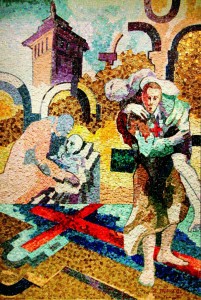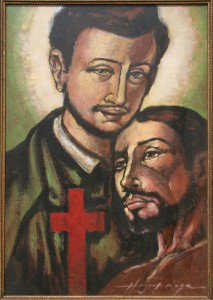 In response to a request made by a Camillian ‘brother’ in order to prepare for a conference on the identity of a religious ‘brother’, our archives produced for us a valuable text which was written thirty-six years ago but which is still of a strong and potent contemporary relevance: Il fratello nell’Ordine dei Ministri degli Infermi (Camilliani)’ (‘The Brother in the Order of the Ministers of the Sick (Camillians)’).
In response to a request made by a Camillian ‘brother’ in order to prepare for a conference on the identity of a religious ‘brother’, our archives produced for us a valuable text which was written thirty-six years ago but which is still of a strong and potent contemporary relevance: Il fratello nell’Ordine dei Ministri degli Infermi (Camilliani)’ (‘The Brother in the Order of the Ministers of the Sick (Camillians)’).
In a few pages, Fr. Calisto Vendrame and the General Consultors went over the cardinal features, in a structural sense, of the identity of the religious brother, the tensions and the crises that this vocational identity has experienced, and also the determination to return in a practical sense to the original insight of the Founder by offering certain realistic pathways of renewal. One need only read even summarily the titles of the sub-sections of the text to see this: the Institute is shared; the novelty of the Camillian proposal; the equilibrium breaks; a return to the spirit of St. Camillus; in the spirit of the Second Vatican Council; in the concreteness of life; fraternal community; a community of service; a suitable training: ongoing training and the promotion of vocations.
St. Camillus really recognised in the sick the presence of the Lord and thus he wanted them to be served as though they were Christ himself. And he immediately realised that this was an impossible undertaking with those employed to provide assistance in hospitals. He did not see any other solution than that of creating a ‘company of pious and good men who not for payment but voluntarily and for love of God would serve them with that charity and lovingness that mothers usually have for their sick children’. Thus a group of secular men who were completely at the service of the sick of the Hospital of St. James where he, a lay man, worked as ‘Master of the House’ (financial administrator).
In remaining secular, however, Camillus would not have been followed by anyone at all. Thus he became a priest and after leaving the Hospital of St. James, with Bernardino and Curzio he began to go every day to the Hospital of the Holy Spirit to serve the sick in their corporeal and spiritual needs. The enormous initial difficulties were addressed by Camillus in the belief that this work came from God and this was shown by the changes which took place over time as regards the first ideas of St. Camillus.[1] The Institute appeared to be very different from all those that already existed and ‘was very far from the thinking of Camillus’[2]. It became a Religion and this was achieved through the joint impact of certain pressing factors and certain personalities who were outside the Foundation.
‘However one point remained fixed in his head: the fathers and the brothers had to work in shared agreement and live service to the sick at a level of equality…This singularity of relationships, which was not to be found in the religious communities of the time, was consequent upon the charism of service to the person of the sick individual in his or her concrete needs…
Care for the sick at the dual health-care and spiritual level was the most relevant aspect of the reform that was set in motion by Camillus. All the Ministers of the Sick were at the service of the sick with substantial complementary tasks that overcame rigid sectorial divisions. The testimonies of religious of the same period as the Founder, the first official documents of the foundation and the proceedings of the first five General Chapters attest to a complete equalisation on the front of shared charitable action…
But putting them on the same juridical level was a matter of dispute and difficulty, as usually takes place when one has to provide juridical clothing to charismatic perceptions…The contrasting dynamics that were present within the Institute from the outset between the clear wish of the Founder for a complete equalisation and the juridical clothing within which it was necessary to move and act, ended up by setting in motion a process of clericalisation to the detriment of the charismatic orientations of the founder’.
 That a deviation could take place was a worry that was felt by St. Camillus until his death and to such an extent that in his ‘Testamentary Letter’ he wrote in a sad way: ‘I do not want to fail to remember union, peace and concord between fathers and brothers because piously speaking the great providence of the Lord, not without cause and mystery, wanted us to have this name of Ministers of the Sick which includes all the fathers and brothers, and the Institute is shared, always intending that we be guided by the second Bull, which established matters for the Order, both for fathers who are priests and for brothers, in what we must do, nor should one look at the fact that the other religions of the Church of God do not walk by this road because their Institute is not shared as ours is, recommending again to all the true and perfect observance of other vows, and each should be careful not to strive under any kind of good to remove from the status of the brothers what the apostolic Holy See has granted to them’.
That a deviation could take place was a worry that was felt by St. Camillus until his death and to such an extent that in his ‘Testamentary Letter’ he wrote in a sad way: ‘I do not want to fail to remember union, peace and concord between fathers and brothers because piously speaking the great providence of the Lord, not without cause and mystery, wanted us to have this name of Ministers of the Sick which includes all the fathers and brothers, and the Institute is shared, always intending that we be guided by the second Bull, which established matters for the Order, both for fathers who are priests and for brothers, in what we must do, nor should one look at the fact that the other religions of the Church of God do not walk by this road because their Institute is not shared as ours is, recommending again to all the true and perfect observance of other vows, and each should be careful not to strive under any kind of good to remove from the status of the brothers what the apostolic Holy See has granted to them’.
After the death of the Founder the Order did not always know how to appreciate sufficiently the originality of its configuration, something that made it different from the other Orders of regular clerics: it was not, that is to say, a lay Order, where the priestly component was only a support for the function of matters of worship and pastoral activity in hospitals, and not even a simple clerical Order where the lay component was entrusted solely with a role of domestic service. It was a religious Order where the two components, with a complementariness of roles and functions. gave life to a new, efficient and complete service as a total response to the needs of sick people’.
A return to the spirit of St. Camillus and the current Constitution. ‘Happily, the renewal achieved by the Second Vatican Council and shaped in the new Constitution led the Order back to the moments of the origins of the Order when fathers and brothers shared the same charism and a single mission. Because it is not only a question of government but also one of faithfulness to the charism and of creativity in relation to it, the ‘question’ of fathers and brothers continues to pose to us new opportunities and also challenges which will have to be addressed in a wise way’.
‘All the religious of our Order share the same charism: we live in the same community, we undertake the same mission, according to each one’s own gifts and the service required by the Institute’ (Constitution, n 14).
‘Our Institute, formed by its nature of religious clerics and lay brothers, called fathers and brothers by St. Camillus, has, as its purpose, the complete service of the sick in the totality of their being. we give our full attention to the sick according to their individual needs and our own capacity and competence’ (Constitution, n. 43).
‘The Order, recognised by the Church as a clerical institute, is comprised of persons united by the bond of profession, traditionally called priests and brothers. As religious, they share a common goal, are equal in dignity and have equal rights and obligations, with the exception of those relative to the exercise of religious orders. The perpetually professed enjoy active and passive voices’ (Constitution, n. 90).
READ THE TEXT HERE: ‘The religious ‘brother’ in the Order of the Ministers of the Sick’














Camillians on Facebook
Camillians on Twitter
Camillians on Instagram